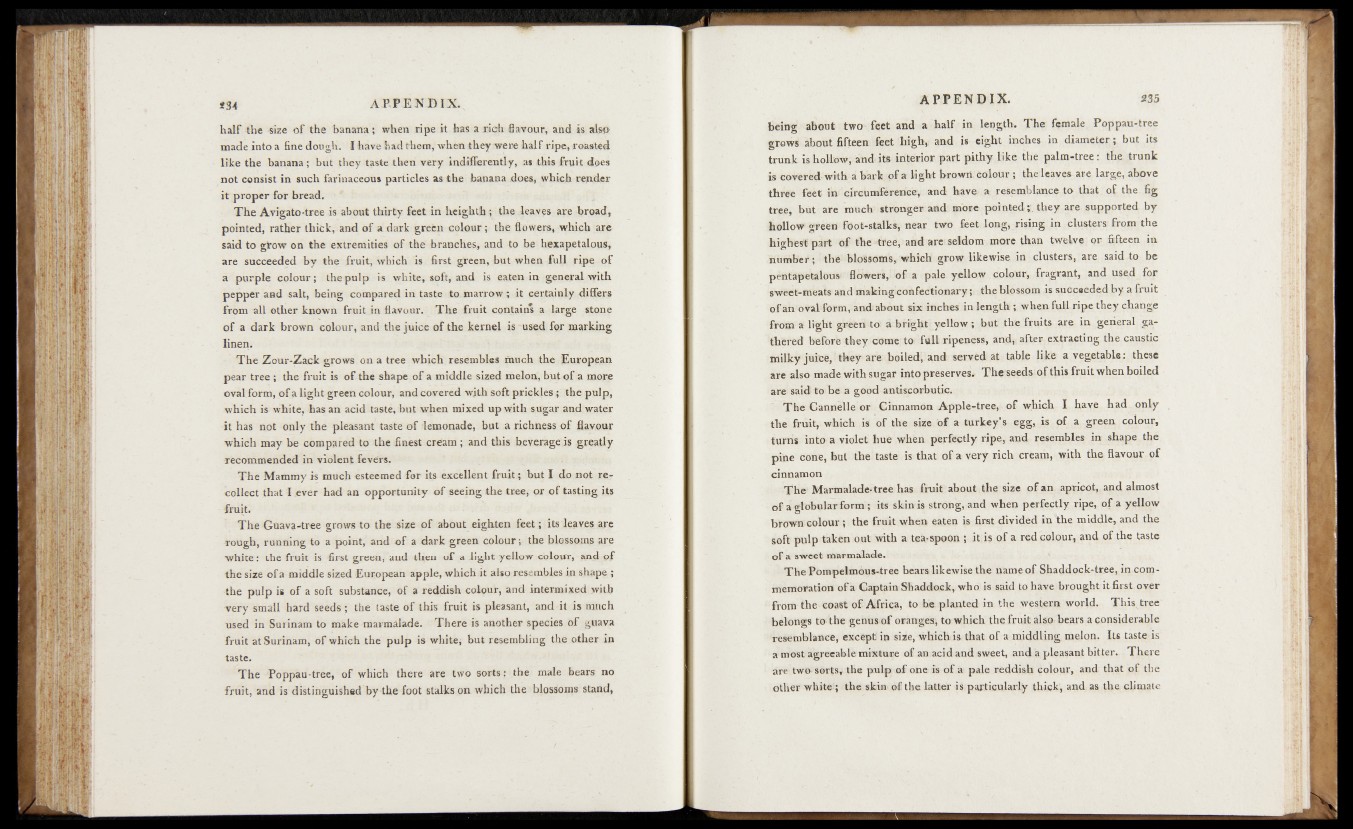
t S 4 A P .P E JSBLXV
half the size o f the banana; when ripe it has a rich flavour, and is also
made into a fine dough. I have had them, when they were half ripe, roasted
like the banana; but they taste then very indifferently, as this fruit does
not consist in such farinaceous particles as the banana does, which render
it proper for bread.
The Avigato-tree is about thirty feet in height}} ? the leaves are broad,
pointed, rather thick, and of a dark green colour; the flowers, -which are
said to gtow on the extremities of the'branches, and to be hexapetalous,
are succeeded by the fruit, which is first green, but when full ripe of
a purple colour; the pulp is white, soft, and is eaten in general with
pepper and salt, being compared in taste to. marrow; it certainly differs
from all other known fruit in flavour. The fruit contains a large stone
o f a dark brown eolour, and the juice of the kernel is 'used for marking
linen.
The Zour-Zack grows on a tree which resembles much the European
pear tree ; the fruit is o f the shape of a middle sized melon, but of a more
oval form, o f a light green colour, and covered with softprickles; the pulp,
which is white, has an add taste, but whoa mixed up with sugar apjliwater
it has not only the pleasant taste o f lemonade, hut a richness of flavour
which may be compared to the finest cream ; and this heverage js greatly
recommended in violent fevers.
The Mammy is much esteemed for its -excellent fruit ? but I do not recollect
that I .ever had an opportunity o f seeing the tree, or of tasting its
fruit.
The Guava-tree grows to the size o f about eighteen feet ,; its'leaves are
rough, running to a point, and o f a dark green eolour; the blossoms are
white: the fruit is first green, and then of a light yellow colour, and of
the size of a middle sized European apple, which it also resembles in shape?
the pulp is of a soft substance, of a reddish colour, and intermixed with
very small hard seeds ? the taste of this fruit is pleasant, and it is much
used in Surinam to make marmalade. There is another species of guava
fruit at Surinam, of which the pulp is white; but resembling the other in
taste.
The Poppau tree, of which there are two sorts : the male bears no
fruit, and is distinguished by the foot stalks on which the blossoms stand,
being about two feet and a half in length. The female Poppau-tree
grows About fifteen feet high,) and is- eight inches in diameter ; but its
trunk is hollow, and its interior part pithy like the palm-tree: the trunk
is covered with a hark of a light browrt ficjleur ; the leaves- aye largo, above
three feet ibcirehmiererice, and have a; resemblance to that o£ the fig
tree, but are much stronger and more pointed ?•. they are supported by
hollow green foot-stalks, near two feet long, rising in clusters from the
highest part of the »«ee, and are seldom more than twelve or fifteen in
number? the blossoms, which grow likewise irt clusters, are said to be
pentApetalouS’ flowers, of a pale yellow colour, fragrant, and used for
sweet-meats and maMng^eonfectionary ?: \ the blossom is succeeded by a fruit
of an oval form, and- about six inches in length ; when full ripe they change
from a light grefert to: i bright; yellow ; but the fruits are in general gathered
before they come to full ripeness, and,, after, extracting the caustic
milky jtofce, they are,fisiled; and served at table like a vegetable: these
are also made with sugar into preserves.* The seeds-of this fruit when boiled
are said to< be a good antiscorbutic.
The Gannelle or Cinnamon Apple-tree, of which I have had only
the fruit, which is of the size of a turkey’s egg, is of a greencolour,
turns into a violet hue when perfectly ripe, and resembles in shape the
pine cone, but the taste is that of a very rich cream, with the- flavour of
cinnamon
The Marmaladertree has fruit about the size o f in apricot,f and almost
o f a globularform ; its skin is strong, and when perfectly ripe, o f a yellow
blown colour; the fruit when eaten is first divided in'the middle, and the
soft pulp taken out with a tea* spoon ; it is of a red colour, and of the taste
of a sweet marmalade.
The Pompelmous-tree hears Likewise the name of Shaddock-tree, in.cojii-
ffleraoration of a Captain Shaddock, who is said tohave broughtitfkst over
from the coast of Africa, to be planted in the western world. This tree
belongs to the genusof oranges? to which the fruit Also, bears a considerable
resemblance, except' ip size, whiehis that of a middling, melon. Its tasteds
a most agreeable mixture of an acid and sweet, and a pleasant bitter. There
are two- sorts, the pulp of one is of a pale reddish eolour, and that of the
other whitei; the skin of the. lattes- is particularly thick', and as the climate